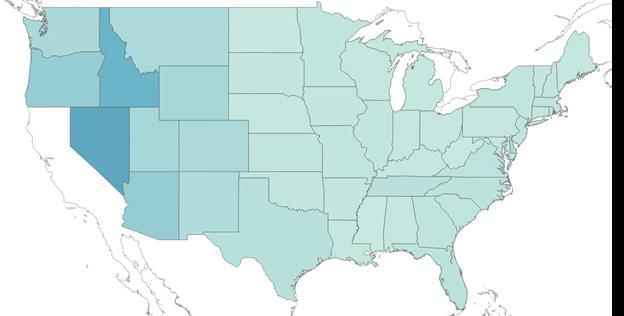
9 minute read
THE ROSE REVIEW
DIRECTOR’S REPORT
Kenneth P. Miller, J.D., Ph.D.

Spring 2023
3 - Student Management Report
4 - Project Updates
6 - Off-Campus Reflections
7 - Senior Farewells
10 - Spotlight: Ryder Todd Smith ’96
12 - Spotlight: Elizabeth Wydra ’98
13 - Speaker Series
14 - Celebrating 25+ Years of Service
15 - Housing Policy Symposium
16 - Rose Celebrates 50 Years
The Rose Institute turns 50 this year. The anniversary gives us a chance to celebrate this special institution and its contributions to generations of Rose students, to CMC, and to the broader society.
The Rose Institute Board of Governors has formed a 50th Anniversary Committee, consisting of Jessica (O’Hare) Witt ’00 (chair), Bob Howard ’55, Henry Olson ’83, and Jacinth Sohi ’11. The committee is working with the Institute and the College to plan events and content commemorating the anniversary. The primary campus events will be a panel and reception on Friday, June 2 (as part of Alumni Weekend), and the main 50th Anniversary Celebration on Friday, October 27 (see the back page of this issue of the Rose Review for more details.) We invite all Rose Alumni to attend these events and hope to welcome many back to campus.
The Institute commissioned graphic designer and Rose Alum Jessica Jin ’16 to create a 50th Anniversary logo. The logo, which appears on the back page of this issue, features a golden “50” surrounding the Institute’s new secondary mark, a classic rosette that is also a stylized image of the interior of California’s state capitol dome. You can look for this logo on “Rose swag” later this year.
A central goal for the anniversary year is to strengthen our connection with Rose alumni. Over the past 50 years, more than 400 students have worked for the Institute and have gone on to pursue impressive and purposeful lives.
Our alumni are one of the Rose Institute’s greatest assets. We stay in close contact with many of them, including those who serve on our Board of Governors, assist with our projects, give talks on campus, and mentor current students. We want to increase our engagement with a larger share of our alumni community. Several years ago, the Board of Governors established the Rose Institute Alumni Society to facilitate connection among our alumni and to connect them with current students. The 50th anniversary is an excellent opportunity to advance this effort.
A group of current Rose students, led by Helen Bovington ’24, is working with Marionette Moore to create a “Profile of Rose Alumni.” The team is collecting recent information on all our alumni and doing a Rose-style data analysis to see what, as a group, they have done after leaving CMC. We look forward to unveiling the profile later this year. A great benefit of this project is that it will help us connect with the whole community of Rose alumni in the coming years.
As we begin our anniversary celebration, I also want to take a moment to commend everyone at the Rose Institute for a highly productive 50th year. Here are some highlights of things we’ve accomplished since publication of the last issue of the Rose Review in October 2022.
In November, the Institute released its most ambitious poll to date, a 50-state pre-election poll with more than
5,000 respondents, including oversamples of the nation’s five most populous states: California, Texas, Florida, New York, and Pennsylvania. The poll, led by Rose Institute Faculty Advisor Andy Sinclair ’08, generated two reports: “Battleground Pennsylvania: The 2022 Election” and “Red vs. Blue States: Competing Visions for 2022 and 2024.” The entire Rose student staff helped execute the poll by coding responses over a long weekend in the Rose workroom. This poll was a major advance in the development of our polling program.
In December, we released the 2022 Kosmont-Rose Institute Cost of Doing Business Survey. Working with our partner Larry Kosmont, we made fundamental changes to this legacy project. The Survey continued to ask the question: How does the cost of doing business compare across different local jurisdictions? But we chose to answer the question in a fresh way, by including new cost variables, introducing data on business exits from California, and adding more advanced forms of data visualization. As revised, the Kosmont-Rose Institute Survey is now fully integrated with the Institute’s focus on California’s competitiveness compared to other states, as well as our expanded use of data visualization.
As noted on page 5 of this issue, the 2022 version of the Kosmont-Rose Institute Survey attracted considerable media attention, in part due to high public interest in business exits from California. Board of Governors Chair Ryder Smith ’96, featured on page 10 of this issue, and his colleagues at Tripepi Smith, assisted with this media effort. The successful rollout of the Survey is the first step in a larger effort to enhance media coverage of Rose Institute research.
This spring, our students, staff, faculty advisors, and consultants have worked on an impressive range of projects on topics including California competitiveness, the state’s housing crisis, city council election systems, characteristics of California’s city managers, issues of city governance, and challenges facing the Inland Empire. Several of those projects are described in the following pages.
In addition, the Institute has continued to provide a forum for discussion of public affairs. Following last fall’s visit by Mark Baldassare (PPIC president and polling director), this spring we hosted Mariano Florentino (Tino) Cuéllar, a former member of the California Supreme Court and now president of the Carnegie Endowment; an Open Academy Salon on criminal justice reform featuring Rafael Mangual and Lara Bazelon; and, most notably, a half-day symposium on California Housing Policy, co-sponsored by the Olson Company. The symposium featured former governor Gray Davis, current and former members of the legislature (including Assembly Housing Committee Chair Buffy Wicks), Los Angeles County Supervisor Janice Hahn, and city officials, including Ontario City Manager and Rose Board Member Scott Ochoa ’93. The participants generated a robust discussion of a vexing topic. We are digesting the ideas presented that day to produce a white paper later this year.
Finally, at the last meeting of our Board of Governors, we welcomed three new members: Sean Elsbernd ’97, Eric Figueroa ’92 P’21, and Lisa Pitney ’89 and prepared to bring on additional members this spring as we add strength to our outstanding board.
In all, it has been an excellent year for the Rose Institute.

The end of the academic year provides an opportunity to celebrate and thank our students. I am pleased to share that one of them, Pieter van Wingerden ’24, has been awarded the Truman Fellowship, one of the nation’s most prestigious awards presented to undergraduates. We also will be celebrating the accomplishments of our graduating seniors at a reception before commencement. I want to specially thank our outgoing student managers, Cameron Stevens ’23, Desmond Mantle ’23, and Tara Mehra ’23 for their excellent service in those essential roles over the past year. I am happy to announce they have been succeeded by Anna Short PO ’24 and Grace Hong ’24. Anna and Grace are off to a great start.
The departure of seniors and elevation of new student leadership has been part of the Rose Institute’s rhythms for half a century. As our history indicates, each year the process sends into the world a group of new Rose alumni well prepared to serve and lead. We wish all of them well.
As the new student managers for the 2023-2024 academic year, we are excited to help lead the Rose Institute into a bright future. We are very grateful for previous student managers Tara Mehra, Cameron Stevens, and Desmond Mantle for all of their hard work and commitment over the past year, and we wish them well as they begin the next chapters of their lives. We would also like to thank our senior staff, Dr. Ken Miller, Bipasa Nadon, and Marionette Moore, for their outstanding leadership and support.
This semester, we have seen our new hire class apply the skills they learned during their new hire research projects last semester to our diverse array of projects, spanning a number of crucial state and local government issues. These have included longstanding Institute priorities, such as the Kosmont Cost of Doing Business Survey and the Miller-Rose Initiative Database, as well as continuing research on business movement to and from California and examining city council redistricting. Student interest has driven one of our new projects, which is analyzing California cities’ compliance with state housing mandates, and another is focusing on the demographics of city managers across the state in partnership with the California City Management Foundation. In preparation for our 50th anniversary, students are updating our alumni database and illustrating the breadth of career paths taken and terminal degrees achieved by Rose alumni.
In addition to the variety of ongoing projects, we have been looking towards the upcoming year to implement a few new priorities. First, we want to continue to expand the Rose’s reach and encourage applicants from all of the Claremont colleges this fall through broader advertising efforts and outreach. We are also interested in providing training opportunities beyond students’ first semester in key areas such as data skills. We hope that this will augment our already robust new hire training program and ensure that our research assistants have the tools they need for their Rose projects, future coursework, and careers. Expanding the Rose Institute’s media strategy will be another crucial component of next year’s agenda, as we seek to build on the success we have had in promoting our polling and firm movement projects in the news and on social media. Lastly, we look forward to strengthening our vibrant student culture and creating more opportunities for student-faculty engagement.
We would also like to thank our student staff, and especially our graduating seniors, for making the Rose such a fun and supportive workplace. Without all of our research assistants, the Institute would be unable to produce the high-quality research that it so consistently has.

Redistricting: City Election Systems
Pieter van Wingerden ’24
The Rose Institute’s Redistricting team analyzed the voting geography of the city councils of California’s 482 incorporated cities, identifying changes from at-large to by-district elections since the California Voting Rights Act was implemented. The team used data visualization tools to document the changes over time and, ultimately, provide valuable insights into recent trends associated with transitioning election methods and litigation against cities with at-large election systems. In addition, the project has laid the groundwork for future research considering city demographic differences, causes for the recent spike in cities transitioning to by-district elections, and the merits and drawbacks of at-large and by-district systems.
California Competitiveness
Anna Short ’24
This semester, the California Competitiveness project has focused on a few different trends in firm behavior to better understand key characteristics of California’s economy and of local economies within the state. First, we are working to identify which California cities have the most high-tech employment as a proportion of total employment. Looking at what these cities are doing to attract or generate these kinds of jobs could help inform other local governments that are interested in growing their technology sectors. We are also examining how often and where differently-sized businesses are moving, and comparing standalone firms with headquarters of firms that maintain subsidiaries with the hope of providing narrower and more specific analysis for these kinds of firms.
Housing Element Project
Ryan Lenney ’25
The Rose Institute’s Housing Element Project is investigating the current misalignment of state and local housing priorities in California by performing a “postmortem” of cities’ first draft Housing Elements. Cities in California have to submit their Housing Elements to the California Department of Housing and Community Development (HCD) for approval, and for the upcoming cycle, HCD has rejected nearly all of the Housing Elements it has reviewed. A team of seven Rose Institute research assistants is analyzing HCD Housing Element feedback letters to identify the sources of each city’s failure.
This project includes the 75 cities in California with populations over 100,000, as well as all cities within the Inland Empire. By analyzing the HCD feedback letters for these cities, Rose Institute researchers will establish the primary causes of HCD rejection across California, as well as create a comprehensive review of Housing Element compliance in the Inland Empire.


Kosmont Cost of Doing Business Survey
Liann Bielicki ’24
The Kosmont-Rose Cost of Doing Business Study is a longtime collaboration between the Kosmont Companies and the Rose Institute that analyzes the business attractiveness of California cities. It also serves as a rite of passage for Rosies that allows us to contribute to a long-running project of over 20 years’ worth of regular data collection. The project this year focuses on 216 cities and seven variables, with a team that is 12 researchers strong. The primary focus is on Southern California, with all 88 cities in Los Angeles County now included, although many other in-state areas and some out-ofstate cities are included as well. The research assistants have collected data on variables such as minimum wage, housing affordability, and sales tax. We have completed the data collection stage and are moving into our sorting and verification process. This will prime us for making observations about this year’s trends and the business attractiveness of the cities and their regions. We will ultimately publish our findings in a report, with the goal of informing residents of their local business policies and understanding the landscape of conditions in California and beyond.

